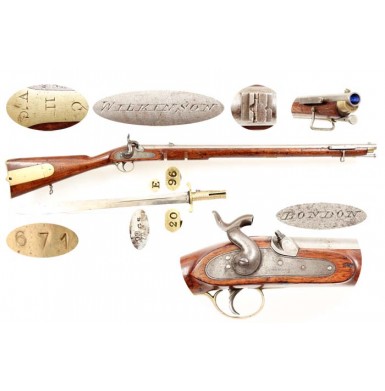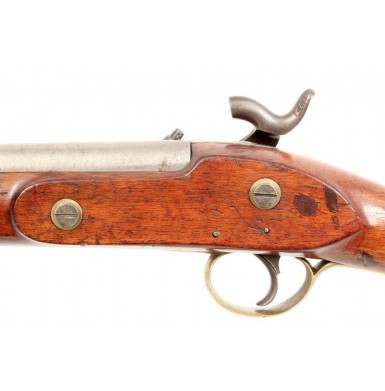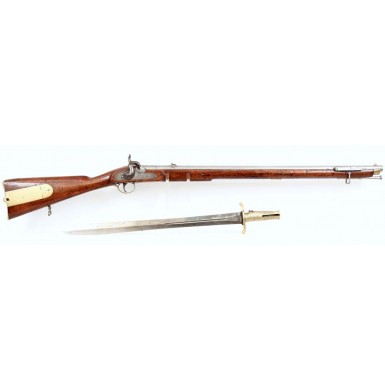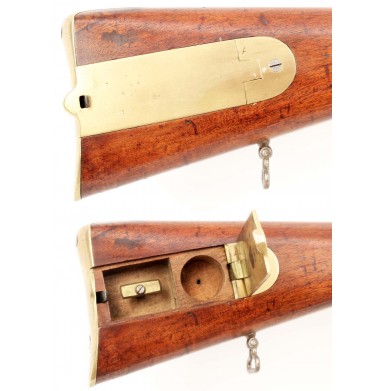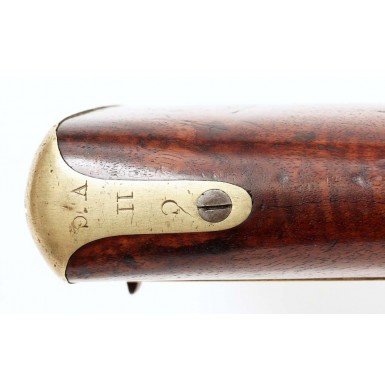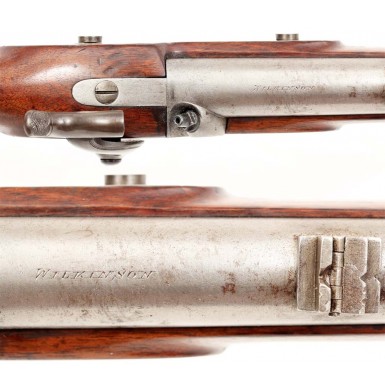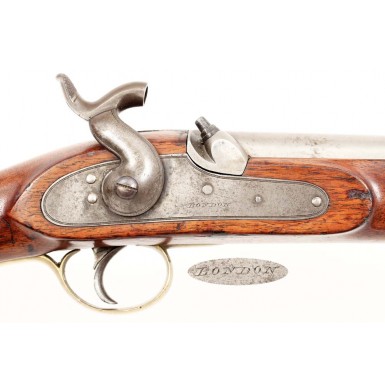Brunswick Volunteer Rifle & Bayonet by Wilkinson
- Product Code: FLA-3100-SOLD
- Availability: Out Of Stock
-
$1.00
In 1836 the British military officially adopted the percussion cap to replace flint as the ignition system for small arms, although it would be 1839 before a new infantry musket using the percussion system would be officially approved and start to be issued in any quantity. With the theoretical acceptance of the new ignition system, George Lovell, inspector of small arms at Enfield, proceeded to start the process of designing a new percussion musket and rifle. His initial success was in a back-action percussion lock that was utilized on his short-lived Pattern 1838 musket, but saw significant service with the newly designed P-1837 Brunswick Rifle. The Brunswick was significant technological improvement over the Baker Rifle that had seen use in the British rifle brigades and battalions for the last 3 decades. The Baker was a flintlock rifle with a slow twist 7-groove barrel. The rifling design had been selected not so much for accuracy, but for its ability to see significant use without becoming too fouled to load. In fact the accuracy (or rather inaccuracy) of the rifle was such that during the last years of production the multi-leaf rear sight was abandoned for a fixed sight, with the Board of Ordnance feeling that the adjustable sight was unnecessary for the rifle or the rifleman! Lovell experimented with a variety of rifling systems for what would become the new Brunswick rifle, and finally settled upon a 2-groove bore of .704 caliber that used a belted ball to insure a tight mechanical fit between the ball and rifling. The new rifle resembled the older Baker in that it did not employ barrel bands, but rather had a key fastened stock and had a heavy bar on the right side of the barrel for the mounting of a saber bayonet. The first version of the Brunswick, the Pattern 1837 had Lovell’s back action lock, a fixed sight with additional leaves for longer range shooting, and a hook breech. The gun went into production in 1838, with the first rifles reaching troops in the field around 1840. In 1841 an improved version was adopted with a conventional side lock and the hooked breech was eliminated. These P-1841 rifles went into production around 1844 and were in the field the following year. The final change came in 1847, when Lacy & Reynolds, a London arms contractor, introduced an improvement to the bayonet mounting bar. Once the new improvement was officially adopted, the final version, the Pattern 1848 came into being. The Brunswick Rifle remained a standard issue long arm for rifle troops until about 1853, when sufficient quantities of the new P-1851 Mini” Rifle had been produced and could be issued, effectively turning all British infantrymen into riflemen. Even after the adoption of the small-bore .577 caliber P-1853 “Enfield”, the Brunswick remained in a secondary issue roll, particularly among native and colonial troops, through the mid-1860s.
About the time the Brunswick Rifle was beginning to be replaced in British military service, a new phenomenon in British nationalism and concern for the defense of the country had manifested itself with the Volunteer Movement. The British military had become somewhat complacent during the long period of European peach in the post-Waterloo era, and had retained the rather outdated, flintlock ignition, India Pattern “Brown Bess’ well into the percussion era. Even after the British military adopted percussion ignition they retained the large caliber smoothbore musket as the standard line infantry weapon, while the rest of Europe was adopting rifled arms for general issue, and in the case of the Prussians, breechloading rifled arms! The French revolution of 1848 which made Louis Napoleon Bonaparte (nephew of Emperor Napoleon Bonaparte I) the president of France unsettled European relations and for the first time since Waterloo, the possibility of a French war with England, and a possible invasion by the French, seemed to be a possibility. With hysteria ginned up by a burgeoning English press, a sense of nationalism and somewhat unrealistic fear of a war with France gripped many young Englishmen, who followed the advice of some of the pamphlets of the day and sought to join Volunteer Rifle organizations. These groups were based upon target shooting clubs that had existed previously, but instead of using specialized sporting rifles, the groups armed themselves with military pattern arms, although they were often enhanced, had special features and did not exactly conform to official military patterns. These organizations, much like pre-Civil War American militia companies usually armed, equipped and uniformed themselves as they saw best, buying what they could afford, sometimes communally, sometimes individually and sometimes at the expense of a wealthy citizen or group of citizen who underwrote the expense. With the coming of the Crimean War and the alliance of France and England during that conflict the Volunteer movement lost some momentum, but not for long. By the latter part of the 1850s, with the war over and the possibility for French expansionism to be renewed, the Volunteers again took up their arms and fever spread throughout England. With the adoption of the Pattern 1853 Enfield and its .577 (25 gauge) bore, the War Department started to set out some rules and regulations for these Volunteer Rifle groups, which were in fact budding militia companies. The first major rule was that all arms utilized would have to accept the standard government issued .577 cartridges. This still left a lot of latitude in the type of “military style” rifle that the volunteers acquired, but the guns were at least all to be of uniform caliber. While Whitworth, Kerr and Alexander Henry .451smallbore rifles are often lumped into the “Volunteer Rifle” category, their caliber excludes them from being true volunteer rifles, and rather they were military style target rifles that could only be used in small bore or “any rifle” matches. The wide variety of variation in the .577 military style rifles acquired by the volunteers was amazing, with some guns being almost exact military pattern arms and some only vaguely resembling them. In an effort to standardize the arms of the volunteers, and because so many older (Type I & Type II) Pattern 1853 Enfields were available for refurbishment and issue to volunteer groups, by 1862 most volunteer organizations were being issued Pimlico refurbished P-1853s dating back to the Crimean War and the Indian Mutiny. The variety of volunteer pattern arms that were available for sale in the gun shops of London and Birmingham circa 1861-1862 is well documented among the many patterns of short rifles that were purchased by the Confederacy and exist today bearing Confederate inspection and inventory numbers. These guns range from checkered P-1856 pattern rifles with extended bayonet lugs and engraved furniture to brass mounted P-1856 Type II “Bar on Band” rifles, both of which outwardly resemble official British military pattern long arms, but do not conform to those patterns. The Confederacy also purchased at least 2,020 “Brunswick” pattern rifles according to the Gorgas Summary of Small Arms purchases made by Caleb Huse, dated February 3, 1863. Huse acquired all of the Brunswick Rifles from S. Isaac, Campbell & Company, who purchased them from J.E. Barnett & Son of London. The guns were acquired in 8 lots between October 31, 1861 and March 27, 1862. To date nine examples of these Confederate purchased Brunswick Rifles are known, all bearing the CH/1 inspection mark Curtis & Hughes, who acted as viewers for Confederate arms purchases in England, usually of guns sold by Barnett. These nine examples vary in features and caliber, with some being .704 2-groove military rifles and some being smaller bore volunteer models. In all cases, even the surplus military gun have upgraded, Pattern 1856 short rifle rear sights.
Offered here is one of those small bore, .577 caliber Volunteer Pattern 1848 Brunswick Rifle, what author and researcher De Witt Bailey refers to as a “Brunswick-Enfield”. The gun essentially conforms to the last British military pattern of Brunswick rifle, with the 1848 style bayonet bar, forward action lock of the Pattern 1841/44, 30 3/16” barrel and the usual large brass patchbox. However, the gun has a .577 three-groove bore and slightly improved rear sight, being a post and two-leaf sight similar to those used on the P-1853 Artillery Carbine and P-1856 Cavalry Carbine, rather than the typical single post and leaf sight of the Brunswick. The gun also has an overall length about ““ longer than the standard military Brunswick, giving it slightly longer (and more comfortable) length of pull. The gun is in about VERY GOOD+ to NEAR FINE condition and although the barrel retains no original finish, the gun remains quite crisp and sharp throughout with fine markings. The lock of the gun is simply engraved LONDON while the barrel is engraved on the top of the breech WILKINSON, the London retailer who sold the gun. The Wilkinson Company could trace its roots to renowned London gunmaker Henry Nock who had established himself in that business in 1772. James Wilkinson was Nock’s son-in-law and was the manager of Nock’s business, which became Nock & Wilkinson in 1785. Wilkinson continued to run the business as James Wilkinson, after Nock’s death in 1804. In 1818 James’ son John would join the business, creating Wilkinson & Son. In 1829 the business moved to their famous Pall Mall address in London, where they would remain through 1888. In 1848 James passed the business on to his son Henry Wilkinson. In 1861 Henry died and the business passed to manager John Latham, and much like the passing of Nock’s business to Wilkinson, the Wilkinson business was now owned by a person whose name was not that of the original company. It was during the mid-19th century that Latham changed the general direction of the business from firearms production to the production of swords and edged weapons, although they continued to retail firearms of all types well into the 20th century. In 1888, Latham’s son established the Wilkinson Sword Company, LTD, which was reorganized as Wilkinson Sword LTD in 1909. During the latter 19th century Wilkinson retailed a large number of Webley and Webley & Scott produced firearms, including the Wilkinson-Webley revolver. Wilkinson started to serial number firearms and blades during the 1850s, and maintained fastidious records regarding the sales of these arms. Today, Wilkinson retailed arms can be researched by their Wilkinson serial number, and a “factory letter”, much like the Colt factory letter can usually be obtained on Wilkinson retailed arms that bear such a number. A research letter regarding specific Wilkinson retailed arms can be order through Richard Milner LTD it the United Kingdom. Research order forms can be obtained through the web site: armsresearch.co.uk . The Wilkinson “day book” records often include the name of the person or company to whom the gun was sold, as well as the date and other notes regarding other items purchased. It is possible that the number 671 stamped into the bottom of the brass buttplate is this Wilkinson serial number, and it might be worth investigating the possibility of obtaining such a factory letter.
As noted the gun is well marked throughout, and not only on the exposed surfaces. The interior of the lock is marked with a1 over the mainspring, and the lock mating assembly marks \ \ | | | appear on the rear edge of the hammer neck, on the lower edge of the bridle and the bottom edge of the lock plate. The top edge of the lock plate bears the assembly mating mark \ | /, which is found throughout the balance of the gun and is the master assembly mating mark. The underside of the barrel is also marked with the same \ | / assembly mark, and also bears the names Pritchett and W. Millward. The Millward mark is that of Birmingham barrel maker who worked from 1829-1839, when the firm became William Millward and Son, continuing in business until 1883. Their most prolific barrel making period appears to be from 1847-1869. The Pritchett mark is that of the famous London gunmaking firm of RE Pritchett & Son (later RT Pritchett), who invented the Pritchett Bullet “ the English version of the Mini” Ball. The firm was started by Samuel Pritchett in 1796 and remained an ongoing family operation through at least 3 generations, with the requisite name changes, the addition of “& Son”, etc, until 1864. It is quite likely that Pritchett made this Brunswick-Enfield and Wilkinson retailed it. The bottom of the barrel shows typical London commercial proofs, further indicating that the London based Pritchett made the gun, while the Birmingham based Millward only supplied a rough barrel, prior to being proved. The rest of the gun shows the same \ | / mating marks, and they are found on the edges of the barrel keys (wedges), both side lock screws, the tang screw, the top edge of the patchbox and the in the rammer channel. The top of the brass buttplate is engraved in three lines with the Volunteer Rifle mark C / 11 / VC and the bottom of the buttplate is stamp-numbered 671. I do not know which Volunteer Rifle organization this mark refers to, but as noted earlier, the “671” may be the Wilkinson serial number. The gun is in about VERY GOOD+ to NEAR FINE condition and the barrel has a smooth, pewter gray patina. The barrel shows some lightly scattered pinpricking along its length, with slightly more pinpricking around the breech and bolster area. The bore is in about VERY GOOD condition with good rifling its entire length along with light pitting scattered along the entire bore. There are also some small patches of more moderate pitting present in the bore, and the rifling is slightly thinner near the muzzle, suggesting that the rifling is of the progressive depth type used on military P-1853 rifle muskets. The lock is mostly smooth and has a mottled gray appearance with a pewter base patina and some areas of darker mottling. The lock is mechanically excellent and functions perfectly on all positions. The rifle retains what appear to be both original sling swivels and its original rear sight, along with the original bayonet mounting bar on the right side of the barrel. An original Brunswick rammer is in the channel under the barrel, and it is full length with good threads on the end. The brass furniture is in very nice condition with a mellow golden patina that is very attractive. The stock is about FINE overall condition with sharp lines and crisp edges. The stock is full length and solid and free of any breaks, cracks or repairs. The stock shows no signs of sanding and remains very crisp throughout. The stock does show a smattering of minor bumps, dings and mars, but nothing beyond typical light use and storage. The gun is accompanied by a VERY FINE British Pattern 1848 Brunswick Saber Bayonet. The bayonet fits the rifle well and latches securely into place when mounted. The blade is full length and retains most of its original arsenal bright polish, with only some lightly scattered patches of minor age discoloration and light surface oxidation. The obverse ricasso is marked with a (CROWN) / E6 Enfield inspection mark and the initials G S, which are probably that of a bayonet contractor. The original buff leather throat washer remains at the junction of the blade and brass hilt. The brass hilt has a mellow golden patina and is crisply marked on the obverse crossguard with the unit designations 96 E 20. The bayonet is really a fine addition to the rifle and matches it quite well.
Overall this is a very crisp and well marked example of a scarce Brunswick “ Enfield Volunteer Rifle, complete with an original Pattern 1848 Brunswick Saber Bayonet. The rifle was retailed by one of the more famous and collectible London dealers, Wilkinson and may be researchable in the Wilkinson ledgers and daybooks. The gun is very attractive and has a good enough bore that it would probably make a good shooter today. This is a nice chance to obtain a scarce Brunswick pattern volunteer rifle in very nice condition, complete with bayonet, with a very desirable retailer mark on the barrel.
SOLD
